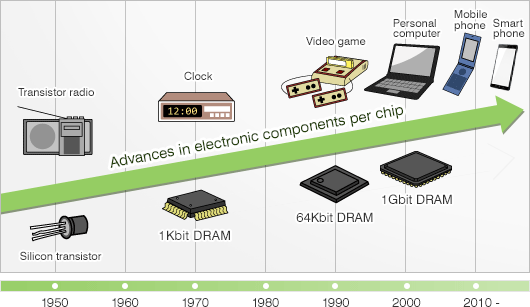
|
Semiconductor Room What are semiconductors? Semiconductor manufacture |
The birth of semiconductors can be traced back to the invention of the rectifier (AC-DC converter) in 1874. Decades later, Bardeen and Brattain at Bell Laboratories in the US invented the point-contact transistor in 1947, and Shockley invented the junction transistor in 1948. This heralded the arrival of the transistor era. In 1946, the University of Pennsylvania in the US built a computer using the vacuum tubes. The computer was so large that its vacuum tubes occupied the entire building, and it consumed a huge amount of electricity and produced a lot of heat. Later, the innovative transistor calculator (computer) was developed, and since then computers have grown by leaps and bounds. In 1956, the Nobel Prize in Physics was awarded jointly to Shockley, Bardeen and Brattain for their contribution to semiconductor research and the development of the transistor.
The semiconductor industry grew rapidly following the invention of the transistor. In 1957, it already exceeded the scale of 100 million dollars. In 1959, the bipolar integrated circuit (IC) was invented by Kilby of Texas Instruments and Noyce of Fairchild Semiconductor in the US. This invention had a major impact on the history of semiconductors, and it marked the dawn of the IC era. Being small in size and light in weight, the IC was widely used in a variety of electric appliances.
In 1967, Texas Instruments developed the electronic desktop calculator (the calculator) using IC. In Japan, electronic equipment manufacturers released calculators one after another, and fierce “calculator wars” continued until the end of the 1970s. IC integration advanced even further, and the large-scale integrated circuit (LSI) was developed. The technologies continue to advance. The VLSI (from 100 thousand to 10 million electronic components per chip) was developed in the 1980s, and the ULSI (more than 10 million electronic components per chip) was developed in the 1990s. In the 2000s, the system LSI (a multifunction LSI with multiple functions integrated in a single chip) was put into full-scale production. As IC progresses toward high performance and multiple functions, its field of application is expanding broadly. Semiconductors are now used in every corner of our society and support everyday life.

|